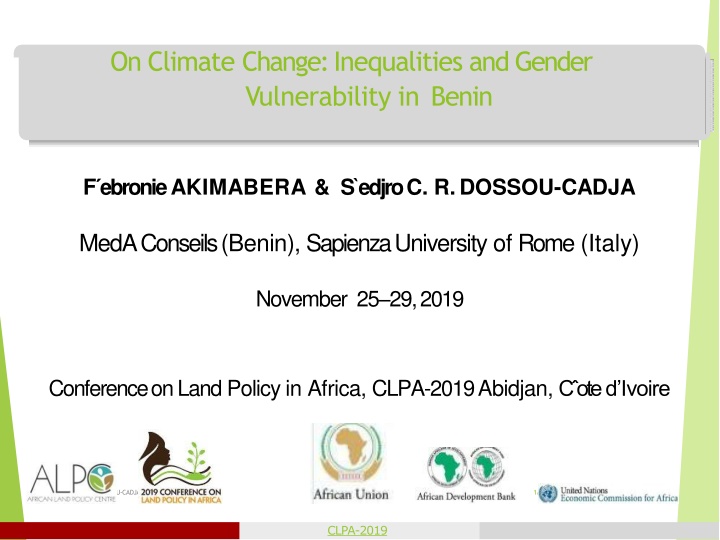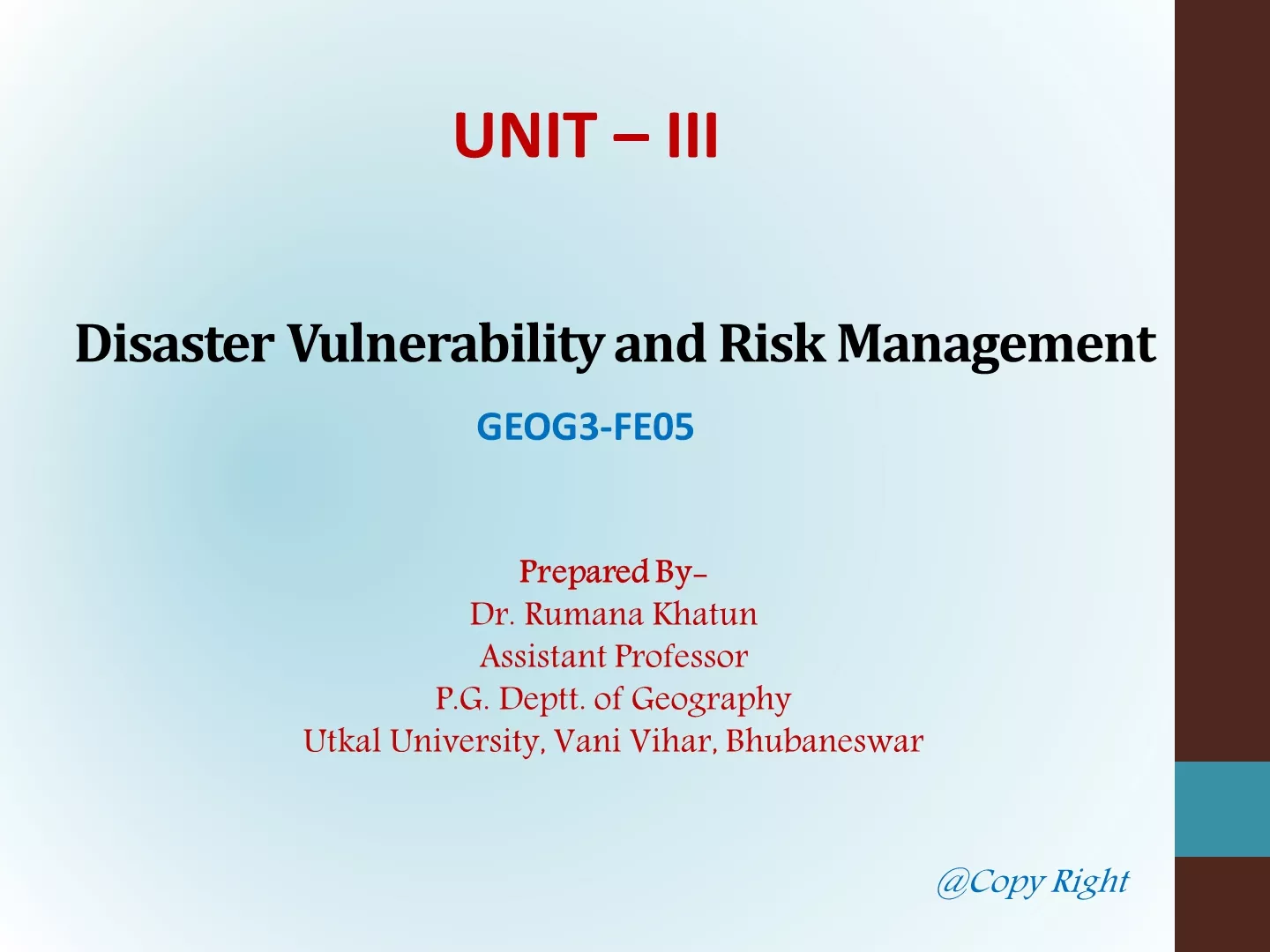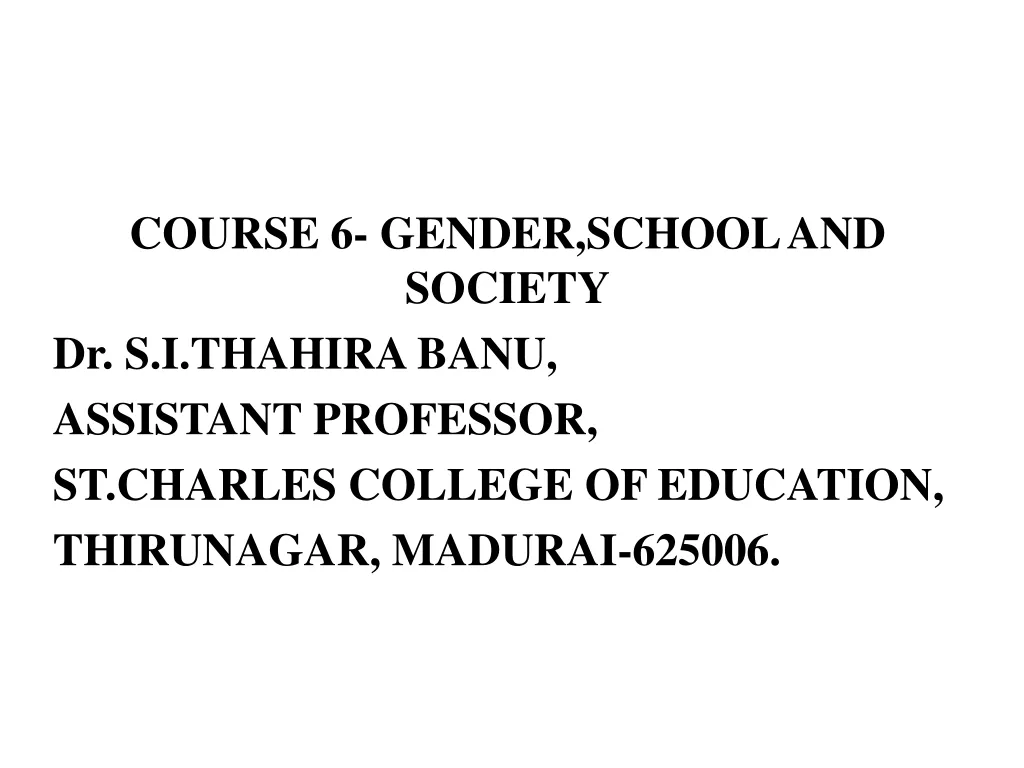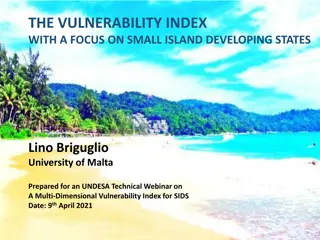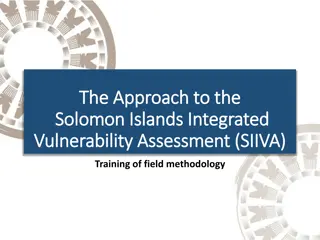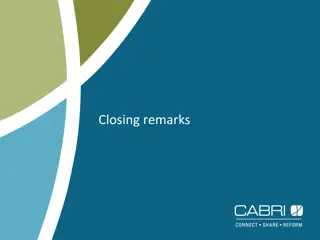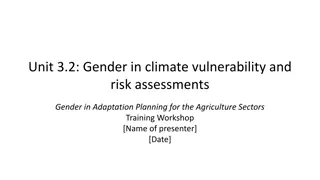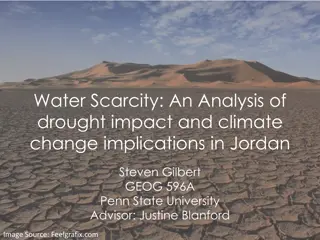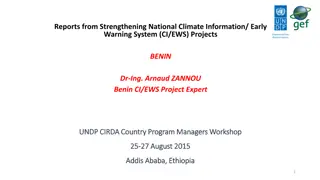Gender Vulnerability to Climate Change: Inequalities in Benin
This study examines gender vulnerabilities to climate change in Benin, focusing on inequalities in adaptation capacities of men and women. It explores how different social roles influence responses to climate shocks in the agricultural sector. The research highlights the need to consider gender disparities in climate change impact assessments for more effective mitigation and adaptation strategies.
Download Presentation

Please find below an Image/Link to download the presentation.
The content on the website is provided AS IS for your information and personal use only. It may not be sold, licensed, or shared on other websites without obtaining consent from the author.If you encounter any issues during the download, it is possible that the publisher has removed the file from their server.
You are allowed to download the files provided on this website for personal or commercial use, subject to the condition that they are used lawfully. All files are the property of their respective owners.
The content on the website is provided AS IS for your information and personal use only. It may not be sold, licensed, or shared on other websites without obtaining consent from the author.
E N D
Presentation Transcript
On Climate Change: Inequalities and Gender Vulnerability in Benin #CLPA2019 F ebronie AKIMABERA & S`edjro C. R.DOSSOU-CADJA MedA Conseils (Benin), Sapienza University of Rome (Italy) November 25 29,2019 Conference on Land Policy in Africa, CLPA-2019 Abidjan, C oted Ivoire F. AKIMABERA & S.DOSSOU-CADJA November 25 29,2 0 1 9 1/ 18 CLPA-2019
Outline Introduction #CLPA2019 Motivation Index of Inequality of Gender Vulnerability to Climate Change (IIVGCC) Application to Benin Agricultural Sector Concluding Remarks F. AKIMABERA & S.DOSSOU-CADJA November 25 29,2 0 1 9 CLPA-2019 2 / 18
Introduction #CLPA2019 In face of climate shocks, responses varie from one society/community to another, from one individual to another depending on the individual and collective capacities to deal withdisasters. Novembe r 25 29, 2019 F. AKIMABERA & S.DOSSOU-CADJA CLPA-2019 3 / 18
Introduction #CLPA2019 In face of climate shocks, responses varie from one society/community to another, from one individual to another depending on the individual and collective capacities to deal withdisasters. Gender analysis in vulnerability to CC therefore integrates, inequalities in men and women adaptation capacities in face of climate shocks, that could degrade their living conditions. F. AKIMABERA & S.DOSSOU-CADJA November 25 29,2 0 1 9 CLPA-2019 3 / 18
Motivation #CLPA2019 Men and women contribute differently to adaptation and mitigation of climate change impacts since there are some difference in their socialroles. Novembe r 25 29, 2019 F. AKIMABERA & S.DOSSOU-CADJA 4 / 18 CLPA-2019
Motivation #CLPA2019 Figure:Distribution of men and women social roles in 3 strategical development F. AKIMABERA & S.DOSSOU-CADJA sectors (Source: MedAConseils) November 25 29,2 0 1 9 5 / 18 CLPA-2019
Motivation #CLPA2019 DSAAT in Agricultural Sector, BenHydro for water demand, and so on, include no input or output data for the differentiated impacts of climate changeonmenandwomen. Novembe r 25 29, 2019 F. AKIMABERA & S.DOSSOU-CADJA CLPA-2019 6 / 18
Motivation #CLPA2019 DSAAT in Agricultural Sector, BenHydro for water demand, and so on, include no input or output data for the differentiated impacts of climate changeonmenandwomen. It thus appears that existing simulation models at sectoral level do not integrate social variables and are not revisable byusers. Novembe r 25 29, 2019 F. AKIMABERA & S.DOSSOU-CADJA CLPA-2019 6 / 18
Question #CLPA2019 How to measure gender inequalities in a given development sector in face of climate changeoccurrence? Novembe r 25 29, 2019 F. AKIMABERA & S.DOSSOU-CADJA 7 / 18 CLPA-2019
Index of Inequality of Gender Vulnerability to climate change(IIVGCC) The proposed methodology IIVGcc is basically inspired by: #CLPA2019 Novembe r 25 29, 2019 F. AKIMABERA & S.DOSSOU-CADJA CLPA-2019 8 / 18
Index of Inequality of Gender Vulnerability to climate change(IIVGCC) The proposed methodology IIVGcc is basically inspired by: #CLPA2019 UNDP Vulnerability Index to Poverty (2011); Novembe r 25 29, 2019 F. AKIMABERA & S.DOSSOU-CADJA CLPA-2019 8 / 18
Index of Inequality of Gender Vulnerability to climate change(IIVGCC) The proposed methodology IIVGcc is basically inspired by: #CLPA2019 UNDP Vulnerability Index to Poverty (2011); Guillaumont economic vulnerability index (2008,2009); Novembe r 25 29, 2019 F. AKIMABERA & S.DOSSOU-CADJA CLPA-2019 8 / 18
Index of Inequality of Gender Vulnerability to climate change (IIVGCC) The proposed methodology IIVGcc is basically inspiredby: #CLPA2019 UNDP Vulnerability Index to Poverty (2011); Guillaumont economic vulnerability index (2008,2009); Guillaumont and Simonet physical vulnerability index to climate change (2012) F. AKIMABERA & S.DOSSOU-CADJA November 25 29,2 0 1 9 CLPA-2019 8 / 18
Index of Inequality of Gender Vulnerability to climate change (IIVGCC) The proposed methodology IIVGcc is basically inspiredby: #CLPA2019 UNDP Vulnerability Index to Poverty (2011); Guillaumont economic vulnerability index (2008,2009); Guillaumont and Simonet physical vulnerability index to climate change (2012) Overall, as a baseline, we have (Rousseau,2001): risks vulnerability = capacities F. AKIMABERA & S.DOSSOU-CADJA November 25 29,2 0 1 9 CLPA-2019 8 / 18
Index of Inequality of Gender Vulnerability to Climate Change(IIVGCC) #CLPA2019 The Climate Change Sectorial Vulnerability Index (CCSVI) for the development sector named S , is defined as the simple arithmetic mean of S risk exposure index (IERs), and the potential CC shock index on S rated by IYs: Novembe r 25 29, 2019 F. AKIMABERA & S.DOSSOU-CADJA CLPA-2019 9 / 18
Index of Inequality of Gender Vulnerability to Climate Change (IIVGCC) #CLPA2019 The Climate Change Sectorial Vulnerability Index (CCSVI) for the development sector named S , is defined as the simple arithmetic mean of S risk exposure index (IERs), and the potential CC shock index on S rated by IYs: CCSVIs = 0.5 IERs + 0.5 Iys, where Ys is the combination of the climatic proxy variables identified for sector S. F. AKIMABERA & S.DOSSOU-CADJA November 25 29,2 0 1 9 CLPA-2019 9 / 18
Index of Inequality of Gender Vulnerability to Climate Change (IIVGCC) #CLPA2019 In fact, wehave: The sub-index of risk exposure before climate change (IERs) defined as: n IERs = RX i i i=1 with i the weight of Xi in the development of sector S, and RXi the vulnerability ratio of the variable Xi. Each Xi is set as a critical identifiable emergence variable/indicator for sectorS. F. AKIMABERA & S.DOSSOU-CADJA CLPA-2019 November 25 29, 2019 10 / 18
Index of Inequality of Gender Vulnerability to Climate Change(IIVGCC) The sub-index of Climate Change shock (IYs) for a given development sector is a simple arithmetic mean of climatic indicators calculated from the potentials climatic variables (which we call the climate proxies) that can influence the considered sector. It is above all the variables such as temperature, rainfall, sea level, the level of rivers, the extent of drought, which participate in the calculation of the sub- index of CC shock. #CLPA2019 F. AKIMABERA & S.DOSSOU-CADJA CLPA-2019 November 25 29, 2019 11 / 18
Index of Inequality of Gender Vulnerability to Climate Change (IIVGCC) The sub-index of Climate Change shock (IYs) for a given development sector is a simple arithmetic mean of climatic indicators calculated from the potentials climatic variables (which we call the climate proxies) that can influence the considered sector. It is above all the variables such as temperature, rainfall, sea level, the level of rivers, the extent of drought, which participate in the calculation of the sub- index of CC shock. #CLPA2019 Consequently, the IIVGCC for sector S isdefined as CCSV I men CCSV I women. IIVGCCs = It therefore measures by development sector, the relative vulnerability of F. AKIMABERA & S.DOSSOU-CADJA men to climate change compared with that of women. CLPA-2019 November 25 29, 2019 11 / 18
Index of Inequality of Gender Vulnerability to Climate Change (IIVGCC) In practice, variables primary data must be standardized for the index calculation, using the min-max standardization procedure asfollows: #CLPA2019 Value Min I = 100 . Max Min F. AKIMABERA & S.DOSSOU-CADJA CLPA-2019 November 25 29, 2019 12 / 18
Index of Inequality of Gender Vulnerability to Climate Change (IIVGCC) In practice, variables primary data must be standardized for the index calculation, using the min-max standardization procedure asfollows: #CLPA2019 Value Min Max Min I = 100 . In the case where a variable is negatively related to the vulnerability, the formula for calculating the index changes. It becomes: Max Value II = 100 or II = 100 I. Max Min NB: The different weights to be used throughout the IIVGCC calculation are not chosen at random. They must be chosen on the basis of a factorial data F. AKIMABERA & S.DOSSOU-CADJA analysis (PCA, MCA,..). CLPA-2019 November 25 29, 2019 12 / 18
Application to Benin AgriculturalSector #CLPA2019 Figure:Architecture of the Gender Vulnerability Index to Climate Change F. AKIMABERA & S.DOSSOU-CADJA (IIVGCC) for the Agricultural Sector (Source: Authors) CLPA-2019 November 25 29, 2019 13 / 18
Application to Benin AgriculturalSector #CLPA2019 Components CC Vulnerability Index (CCSVI) Men Women ipivi ipivi Risk exposure before the shock of CC Shock ofCC CC Vulnerability Index(CCSVI) Gender Vulnerability Inequality Index to CC ( IIVGcc ) = 0.90 Source: Authors calculations based on EMICoV2011 data 71.60 81.50 28.63 Men 50.115 Women 55.115 CCSVI men = 50.115; CCSVI women = 55.115; IIVGCCA = 0.90. F. AKIMABERA & S.DOSSOU-CADJA CLPA-2019 November 25 29, 2019 14 / 18
Application Findings #CLPA2019 Women are 1.10 times (inverse ratio of IIVGCCA) more vulnerable to Climate Change than men in the Beninese agricultural sector. F. AKIMABERA & S.DOSSOU-CADJA CLPA-2019 November 25 29, 2019 15 / 18
Application Findings #CLPA2019 Women are 1.10 times (inverse ratio of IIVGCCA) more vulnerable to Climate Change than men in the Beninese agricultural sector. The access to land parameter contributes to 50% of the inequalities of vulnerability, whilst the instruction parameter accounts for 37%. F. AKIMABERA & S.DOSSOU-CADJA CLPA-2019 November 25 29, 2019 15 / 18
Application Findings: PolicyImplications #CLPA2019 This result suggests the implementation of social policies in favor of women in the agricultural sector in Benin suchas: F. AKIMABERA & S.DOSSOU-CADJA CLPA-2019 November 25 29, 2019 16 / 18
Application Findings: PolicyImplications #CLPA2019 This result suggests the implementation of social policies in favor of women in the agricultural sector in Benin suchas: Promotion of women s access to land and tenuresecurity, F. AKIMABERA & S.DOSSOU-CADJA CLPA-2019 November 25 29, 2019 16 / 18
Application Findings: PolicyImplications #CLPA2019 This result suggests the implementation of social policies in favor of women in the agricultural sector in Benin suchas: Promotion of women s access to land and tenure security, Promotion of literacy and education of girls andwomen. F. AKIMABERA & S.DOSSOU-CADJA CLPA-2019 November 25 29, 2019 16 / 18
Concluding Remarks The issue gender mainstreaming in modeling the impacts of climate change by development sector is actual, since existing models lack of consistency in terms of taking into account difference of gender social roles. #CLPA2019 F. AKIMABERA & S.DOSSOU-CADJA CLPA-2019 November 25 29, 2019 17 / 18
Concluding Remarks The issue gender mainstreaming in modeling the impacts of climate change by development sector is actual, since existing models lack of consistency in terms of taking into account difference of gender social roles. #CLPA2019 The proposed methodology of Index of Inequality of Gender Vulnerability to Climate Change (IIGVCC) is overall, a modeling by development sector, of gender vulnerability inequalities to climate change. F. AKIMABERA & S.DOSSOU-CADJA CLPA-2019 November 25 29, 2019 17 / 18
Concluding Remarks The issue gender mainstreaming in modeling the impacts of climate change by development sector is actual, since existing models lack of consistency in terms of taking into account difference of gender social roles. #CLPA2019 The proposed methodology of Index of Inequality of Gender Vulnerability to Climate Change (IIGVCC) is overall, a modeling by development sector, of gender vulnerability inequalities to climate change. In line with building sustainable resilience against climate change, National Adaptation Programs (NAP), future studies and projects may consider collecting data, and monitoring the IIVGCC calculation for all key development sectors in Benin, ECOWAS, and Africa at F. AKIMABERA & S.DOSSOU-CADJA large. CLPA-2019 November 25 29, 2019 17 / 18
THE END!! Thanks to #CLPA2019 Contacts: febronie.codja@meda-conseils.com; rdoscadj202@gmail.com, dossoucadja.1889522@studenti.uniroma1.it F. AKIMABERA & S.DOSSOU-CADJA CLPA-2019 November 25 29, 2019 18 / 18
